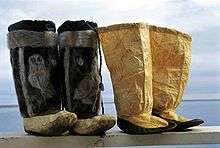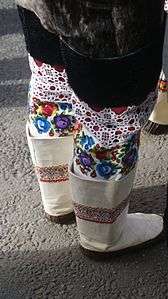Mukluk
Mukluks[1] or kamik (Inuktitut: ᑲᒥᒃ [kaˈmik][2]) (singular: ᑲᒪᒃ kamak, plural: ᑲᒦᑦ kamiit) are a soft boot, traditionally made of reindeer (caribou) skin or sealskin, and worn by Arctic aboriginal people, including the Inuit, Iñupiat, and Yupik.[3]

Mukluks may be worn over an inner boot liner and under a protective overshoe.[4][5] The term mukluk is often used for any soft boot designed for cold weather, and modern designs may use both traditional and modern materials.[6] The word "mukluk" is of Iñupiat and Yupik origin, from maklak, the bearded seal, while "kamik" is an Inuit word. In the Inuipiaq language the "u" makes an "oo" sound, and so the spelling "maklak" is used with the same pronunciation.
Related boots
Another type of boot, sometimes called an Inuit boot, originating in Greenland and the eastern part of Alaska, is made by binding it with animal cartilage, and has a centre seam running down to the foot of the boot.
Another type has a soft leather sole, but the upper is knitted out of wool or a wool-rayon blend. Often called "Slipper Socks", these are traditionally worn by the people of the Hindu Kush Mountains.
In the early 1990s, Métis entrepreneur Sean McCormick went into the mukluk business and launched Manitobah Mukluks.[7] The shoes were based on traditional Métis footwear with a city-friendly rubber sole and the brand quickly became the fastest-growing footwear line in Canada.[8] In 2006 many celebrities were seen wearing the footwear which created demand for them worldwide.[9] In 2012 Adam Azimov produced a video documenting efforts to interest fashion leaders in wearing mukluks.[10][11]
Function
As mukluks are soft-soled, and flex with the feet, they allow hunters to move very quietly. A wearer can run, tip-toe, and even dance in mukluks. They are also designed for use in the tundra.[6]
Mukluks weigh little. While, for instance, U.S. Marine extreme-cold-weather boots weigh eight pounds (4kg), soft-soled boots made using modern materials weigh less than a tenth of that.[12][13] Because mukluks weigh little, there is no need for heavy lacing; friction is enough to hold them on the foot. Some mukluks are very lightly laced (through external loops sewn into the seams, so as not to leak). They may be laced over the arch of the foot, or around the top of the boot to stiffen it.[14] Many, however, have no lacing to constrict the circulation and make the foot cold. The top of the boot stands up somewhat stiffly, and may be open at the top, which allows moisture to escape.
The design of the mukluk is used for the industrial manufacture of cold-weather boots, especially paired with a rugged contemporary sole. The key component of its success is its ability to breathe, that is, to allow air exchange. This is an advantage in extremely cold conditions where perspiration may become a factor in frostbite on one's feet. The bulkiness paired with their poor performance in slush makes them less ideal for the casual winter wearer.[15]
Manufacture
.jpeg)
Mukluks are often made with a wrapped sole, so that the seam around the sole is on the top and sides of the boot, not on the bottom edge. This helps avoid wear on the seams and leaks.
Kamiks made for cold, dry winter weather may have fur low down on the outside, and other features that would be a problem when not on dry, powdery snow. Kamiks for warm, slushy, muddy, or open-ocean conditions are stitched finely from waterproof sealskin (see illustration, top left).[16] Blind-stitching (not piercing the full depth of the skin) with sinew, which shrinks when wet, helps keep mukluks watertight.[4][16] Commercial boots of modern materials will often require seam-sealing after purchase if they are to be fully waterproof.
Usually, the uppers of summer kamik are made ringed seal skin, while the soles are made of bearded seal, which is tougher. The skin requires laborious preparation.[16] Winter kamik are often made of caribou leg fur; caribou, unlike seals, rely on fur rather than blubber for insulation, so their fur is warmer.[4][16]
The short overshoes may also be made waterproof for wet conditions[16] or furry and grippy for dry ones.[5][4]
For insulation, mukluks may be lined with furs such as caribou, rabbit, fox and raccoon. Down, polyester, and closed-celled EVA foam is also used in soft-soled boots.[13] The inner boot is often made with the fur facing inwards.[4] It may also be made of textile.
Mukluks may be adorned with pompons, beads, embroidery, and other methods.
After a year's storage, traditional skin kamiks tend to stiffen and need to be worked and stretched to make them pliable again.[4]
Gallery

.jpg)
.jpg) Kamiks, winter and summer, with their inners removed and stood separately. The exposed parts of the winter liner are decorated.
Kamiks, winter and summer, with their inners removed and stood separately. The exposed parts of the winter liner are decorated.- Alaskan boots, Inupiat, 1989, bearded seal, ringed seal, spotted seal, caribou, polar bear
See also
| Wikimedia Commons has media related to Category:Kamiks. |
| Wikimedia Commons has media related to Category:Eskimo boots. |
References
| Look up mukluk or kamik in Wiktionary, the free dictionary. |
- "Mukluk". Canadian Icons. Retrieved 2019-03-20.
- "kamik". Inuktitut Living Dictionary. Retrieved September 14, 2012.
- "What Are Mukluks?". www.wonderopolis.org. Retrieved 2019-03-20.
- http://www.johntyman.com/arctic/inuit201.html
- http://firstpeoplesofcanada.com/fp_groups/fp_inuit5.html
- "Mukluk". The Canadian Encyclopedia. Historica Canada. October 20, 2015. Retrieved August 18, 2019.
- "Turning into a global brand - An entrepreneur's story". BDC. Retrieved 2019-03-20.
- "How a little company from Manitoba is taking over the world one moccasin at a time". Retrieved 2019-03-20.
- "Manitobah Mukluks". Manitobah Mukluks. Retrieved 2019-03-20.
- Richard L. Daft; Ann Armstrong. "Organization Theory and Design 3CE". Nelson Education. p. 581. ISBN 9780176599461. Retrieved 2019-09-07.
- "Manitobah Mukluks: The story behind the Boots Worn by Kate Moss and Megan Fox" (video). CBC News. 2012-02-24. Retrieved 2019-09-07.
- https://www.taigaworks.ca/cart.php?m=product_detail&p=51
- https://www.mec.ca/en/product/5031-589/Expedition-Plus-Bootie
- freyahoffmeister.com/expeditions/greenland-national-championships-in-sisimiut-2006/
- John, Long (2000). The Complete Hiker. ISBN 0-07-135818-8.
- http://www.johntyman.com/arctic/inuit202.html